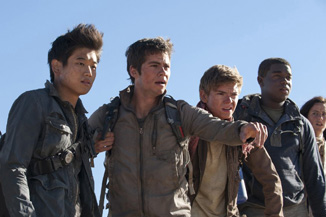Movie Review - Maze Runner: The Scorch Trials
By Ben Gruchow
September 22, 2015
BoxOfficeProphets.com

The Scorch Trials is based very loosely on the novel of the same name by James Dashner. It is directed, like the first film was, by Wes Ball. If there’s one thing I’m prepared to grant the movie, it is consistency. Ball hasn’t grown much as a director from last year, but he hasn’t actively regressed either, and this year’s iteration is really no better and no worse than the original. It has higher highs and lower lows, so it all kind of averages out to the same experience. The crucial factor is that The Maze Runner wasn’t a good movie, so something that operates on roughly the same cinematic plane - right down to the ending being one long sad-trombone effect - doesn’t exactly set the blood on fire.
This one also begins somewhat in medias res: having been rescued from the formidably giant manmade structure in the first film, the Maze Runners (i.e. our teenage protagonists, led by Dylan O’Brien as the surname-less Thomas) are being spirited away to a giant facility in the middle of a desert called the Scorch. It’s far in the future, the earth has been mostly destroyed, and the only surviving installations are the sort of military-industrial ones that we see here. Heading the facility is Janson (Aiden Gillen, struggling mightily with an American accent and succeeding not even a little bit); he promises the Runners food and shelter and safety, but there are doubts and odd rules and behaviors and the immortal line, “Who’s side are you on?” Most of the remaining population has been zombified (they’re called Cranks in the movie, but don’t be fooled: they’re desiccated, they shamble around and gurgle, and a bite or scratch from one of them is enough to turn a reasonably healthy Runner into the undead. Also like zombies, they’re not even a little bit scary).
Thus do we find ourselves at the 10-minute mark of a 131-minute movie, and the setting and storyline has about exhausted itself. We know that the Runners are going to escape in the early going, and the rest of the movie plays out as a series of vignettes, each of which exhibit more or less the same traits. We are introduced to a small roster of new characters; they’re onscreen long enough to dispense some new bit of exposition, and we move on to the next roster. There’s an overall goal, and a lot of speed, but little traction or momentum. The only people we’re with for the entirety of the running time are our core cast of Runners, and the movie’s breakneck pace ensures that none of them are developed enough (or onscreen long enough) to capture our sympathy or investment.
There is the nugget of an interesting idea here again. Just like the first movie had the potential to explore social roles and peer pressure, this one has the opportunity to investigate the mindset of an antagonist who’s only the antagonist because of a certain point of view. That possibility only really shows up at the very end, though, and it’s glossed over. The final scenes are horrendous; in the space of only a few lines, it manages to nullify all that was remotely thorny and complex about the motivations of any character involved.
That overall goal is to reach something called the Right Arm; who or what this organization is or does is never clearly delineated, except for a general consensus that they’re the good guys. The crux of the conflict in this universe appears to hinge on one group’s pursuit to find a cure at the expense of any humanitarianism, and another group’s attempt to sabotage their abuse of power. This is a concept very fuzzily expressed, and you could almost look at the rapid change-outs of the supporting cast and each new vignette as an attempt to restart the story’s engine and establish some actual stakes. This is an impression not reassured by a quick glance at the source novel, which the film is a radical departure from - fundamentally different in incident and character motivation, if not in tone.
There’s visible effort expended here to make this material resonate onscreen, and the new direction of the story does at least expand the scope of the thing. As if to counterweight this, though, the movie’s sense of period is even screwier than it was the first time around, when the wardrobe choices made it seem like the movie’s costume designer had $300 and a couple of hours in a discount clothing store to pull together the entire movie’s outfits. Here, it’s even more spurious: with the combination of the clothing, the vehicles, and the thoroughly-contemporary vernacular by the characters, there’s no reason to believe that the movie is taking place in any year except 2015 - a bombed-out alternate-reality 2015, sure, but still the present day.
One of the core components of any successful fantasy series is good internal reliability and consistency, as well as a sense of real consequence: the shakier the concept, the more inconsequential the result. Harry Potter and The Hunger Games pass this test, even if both properties do require a couple of small leaps of faith (when, exactly, do Hogwarts students learn about math or economics or composition?); Divergent does not, and Twilight exists somewhere in its own abstract phase of existence where everyone operates at the level of a hormonal teenager anyway. The Maze Runner occupies an uneasy halfway point: the decimation of population by solar flare and disease, and the scientific pursuit of a cure to that disease, is a suitable foundation to build your story on. But there’s no real building going on here, just random exposition and orientation and reversals, bookending occasionally impressive but ultimately arbitrary action sequences. Navigating through this world is like playing in a sandbox set below tideline.